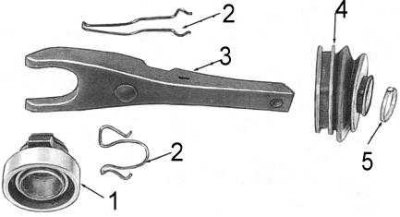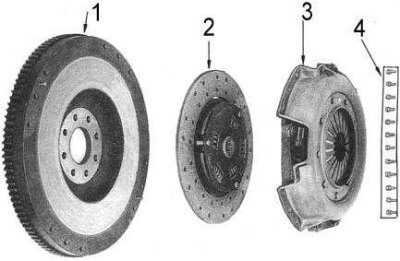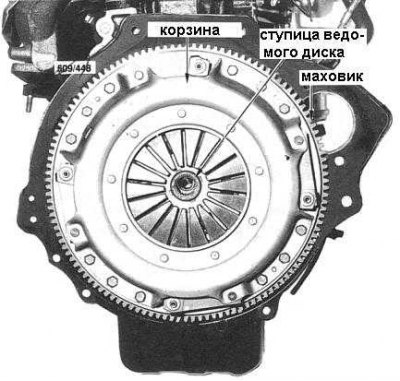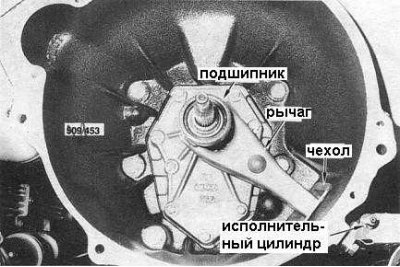Note. You will need a Driven Centering Tool to perform the procedures below (for clutch installation) and a sliding-faced puller or hammer (to replace the guide bearing bush).
Removing
1. Remove transmission from the car.
2. Pulling the inner end of the clutch release lever, remove the lever from the spherical support, then remove it together with the rubber protective boot and bearing from the clutch housing.
3. Release the clip and remove the release bearing assembly with holder from the clutch release lever.
4. Release the clamp and remove the rubber boot from the release lever (the components of the clutch release mechanism are shown in the accompanying illustration).

1 - bearing; 2 - clamp; 3 - lever; 4 - case; 5 - collar
5. Fix the pusher in the clutch slave cylinder to prevent the piston from being pushed out of the cylinder.
6. Mark the position of the clutch basket in relation to the flywheel (during assembly, it must be observed).
7. Gradually loosen the mounting bolts and remove the basket assembly and driven disc from the flywheel (the internal components of the clutch are shown in the accompanying illustration).

1 - flywheel; 2 - driven shaft; 3 - clutch basket; 4 - bolts
Checking the Status of Components
1. Inspect the surface of the friction linings of the clutch disc. If there are signs of wear, polished areas or traces of oil contamination, replace the driven disk.
2. If the disc is found to be suitable for further use, do not allow it to be contaminated with oil, grease, cleaning or hydraulic fluid, etc. under any circumstances.
Note. If the friction linings are worn up to a height of 0.3 above the rivet heads, the driven disk must be replaced. If traces of oil are found on the disc, the source of the leak must be identified and repaired.
3. Make sure that the driven disk of its hub is securely seated. Check the condition of the damper springs.
4. Check up a condition of components of a basket of coupling. Assess the degree of wear of the petals of the diaphragm spring of the pressure plate, check for cracks in them. Inspect the basket body for signs of deformation. Minor defects can be eliminated with fine sandpaper.
5. Inspect the surface of the flywheel for cracks caused by overheating, burn marks, scratches and burrs. Remove light defects with fine sandpaper.
Note. A severely damaged flywheel must be replaced.
6. Check the pilot bearing bush at the end of the crankshaft for signs of wear and damage. If necessary, remove the bushing using a puller or sliding-faced hammer and install a new one in its place (using a special tool with a stepped mandrel). When properly installed, the bushing should protrude 5.8 mm from the end of the crankshaft.
7. Check up a condition of the lever of deenergizing of coupling, fixing clips and a spherical support. If there are signs of severe wear or fatigue information, replace the defective components.
8. Check the proper functioning of the release bearing (the bearing must rotate freely and silently). Remove the bearing from the holder only to replace it. Installing a new bearing is done by pressing its inner race.
9. Replace any defective components.
Note. When cleaning clutch components, do not immerse the release bearing in cleaning fluid. The bearing is filled with grease at the factory and does not require additional lubrication.
Installation
Installation is in the reverse order.
1. Lightly lubricate the gearbox input shaft splines with lithium-based molybdenum disulphide grease. In the case of installing a new driven disk, check the freedom of movement on the splines of the pin of the input shaft. Remove the new disk from the shaft and remove from the components (shaft trunnion and disc hub) excess lubricant.

2. Place the driven disc on the flywheel with the protruding sections of the damper springs towards the clutch basket. Fix the disc in the installation position with a special centering tool (a suitable tool can be made from a piece of wood or a round metal rod - see accompanying illustration - dimension A = input shaft centering journal ø, B = driven disk hub inner ø).
3. If the clutch basket has not been replaced, achieve alignment of the landing marks applied during the dismantling process.

4. Screw in bolts of fastening of a basket to a flywheel. Tighten the bolts diagonally, evenly, in several steps to the required torque. The clutch assembly mounted on the flywheel is shown in the accompanying illustration.
Note. To avoid damage to the basket mounting bolts, make sure that all of them are screwed in before you start tightening them. Tighten according to the instructions above in this paragraph.
5. Remove the centering tool from the driven disc hub.
6. Lightly lubricate the ends of the clutch release lever and its spherical bearing with lithium-based molybdenum disulphide grease.
7. Lubricate the contact points of the release bearing holder with a small amount of the same grease and fill the recess in the holder socket.
8. Put on the rubber protective cover on the switch-off lever.
9. Connect the release bearing assembly with holder to the clutch release lever and install the retaining clip.

10. Insert the lever/bearing assembly into the clutch housing, making sure that the retaining clip snaps into place firmly on the spherical support of the lever (the release mechanism installed in the clutch housing is shown in the accompanying illustration). Also check the reliability of fastening the protective cover with a clamp. Lubricate the joint of the boot with the surface of the clutch housing with silicone sealant.
11. Loosen the pusher of the clutch slave cylinder.
12. Install the transmission on the vehicle.
13. Check the adjustment of the height of the position and free play of the clutch pedal, if necessary, make adjustments.